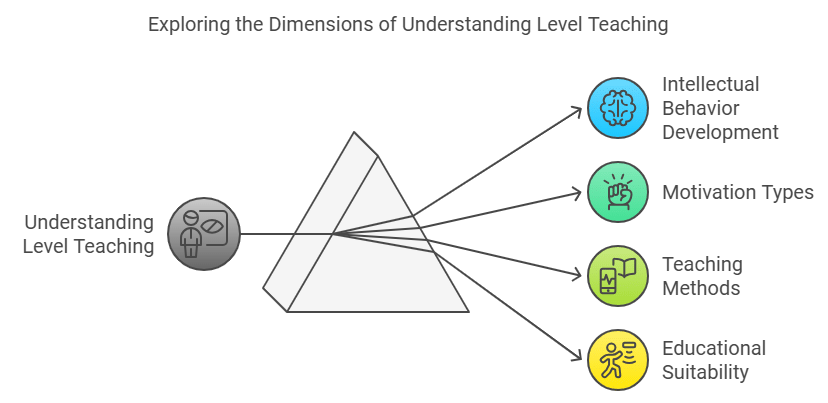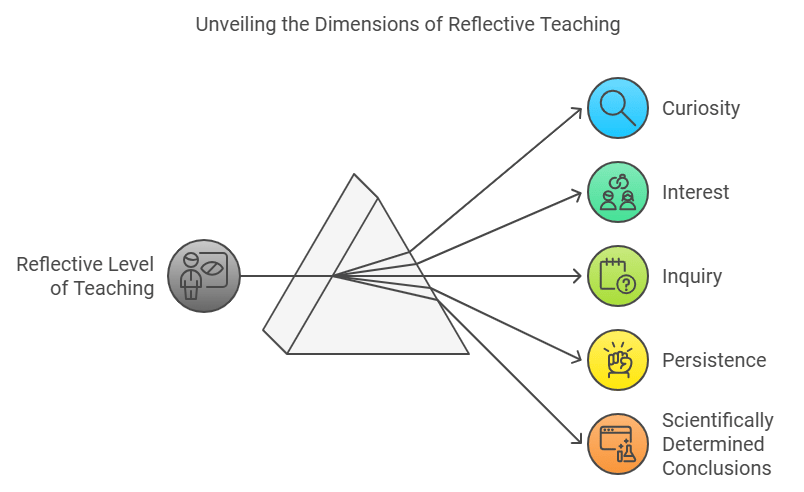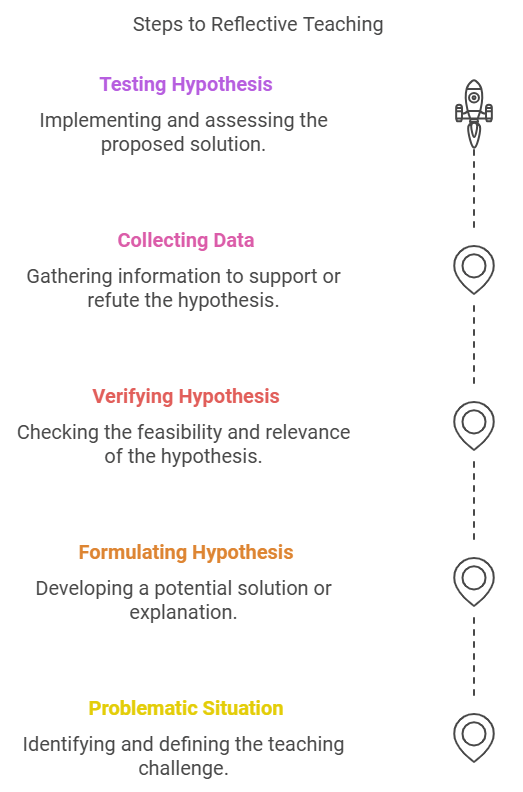Notes: Levels of Teaching | Teaching Aptitude for Teaching Exam - B.Ed Entrance PDF Download
| Table of contents |

|
| Levels of Teaching |

|
| Memory Level of Teaching |

|
| Understanding Level of Teaching |

|
| Reflective Level of Teaching |

|
Levels of Teaching
Teaching and learning activities can be organized at various levels of abstraction, ranging from the application of simple mental powers to the most complex ones. Through teaching, the teacher aims to bring about desirable changes in the learner.
Teaching and learning are interrelated, with the ultimate goal being the development of the learner's all-round personality. Teaching involves interaction between an experienced person (teacher) and an inexperienced person (student). There are three identifiable levels of teaching and learning activities:
- Memory Level of Teaching (Herbart's Teaching Model)
- Understanding Level of Teaching (Morrison's Teaching Model)
- Reflective Level of Teaching (Hunt's Teaching Model)
Memory Level of Teaching
The first level of teaching is the memory level, also referred to as thoughtless teaching. This level, advocated by Herbart, focuses on memorization and is usually used in lower classes. The instructional setup helps learners in cramming the presented content, making the teaching-learning process mainly a Stimulus-Response (S-R) mechanism. According to the educationist Woodsworth, “Memory is the direct use of what is learned.” 
At this level, emphasis is on presenting facts and information for memorization. Teaching and learning at this level involve committing factual material to memory through three major aspects:
- Learning of the material
- Retention of the material
- Reproduction of the material as needed
Objectives:
- Knowledge gained by the learner is factual and acquired through memorization and rote learning.
- It covers only the knowledge-based objectives of Bloom's Taxonomy.
- Teaching is subject-centered.
- Simple, memorable content is taught to students.
- The subject material is well-organized and simple in nature.
- Knowledge delivered is definite, structured, and observable.

Structure: Herbart’s steps in Memory Level of Teaching include:
- Preparation: Questions are asked to test previous knowledge.
- Statement of Aim: Acquainting students with the topic.
- Presentation: Stimulating mental activity and providing opportunities for self-learning.
- Association: Establishing mutual relationships among facts, events, and experts by comparison.
- Generalization: Formulating principles and laws for future situations.
- Application: Using newly learned knowledge in new situations.
 Psychological Basis: According to Jean Piaget, “Memory level is meant for starters,” as learners are at the pre-operational level of cognitive development and cannot operate upon abstract concepts. Pavlov and Skinner’s conditioning theory supports the concept that correct responses are reinforced to retain learned material longer and facilitate further learning. Pavlov's classical conditioning involves a mechanical process applied at the memory level, where correct learning by the student is awarded and retained for future use.
Psychological Basis: According to Jean Piaget, “Memory level is meant for starters,” as learners are at the pre-operational level of cognitive development and cannot operate upon abstract concepts. Pavlov and Skinner’s conditioning theory supports the concept that correct responses are reinforced to retain learned material longer and facilitate further learning. Pavlov's classical conditioning involves a mechanical process applied at the memory level, where correct learning by the student is awarded and retained for future use.
Teaching Method: The teaching method at this level is subject-centered, aiming to make students memorize the subject. Methods include drill, review, revision, and questioning. Drill involves constant practice and repetition, review involves forming new associations, revision clarifies concepts, and questions examine objective achievement. The teacher’s role is active, deciding on content, techniques, and methods, while the learner’s role is passive. Teaching aids like audio-visual aids, models, charts, maps, pictures, TV, and radio are used.
Evaluation System: Evaluation includes essay and objective-type questions, with oral tests checking memorization levels. Tests and tools need proper planning to evaluate comprehension, grasp, analysis, synthesis, and discrimination abilities. Examples include fill-in-the-blank, matching, short answer, MCQs, recall type, and recognition questions.
Suggestions:
- Teaching material should progress from simple to complex.
- Material should be objective and useful.
- Teaching aids should be adequate, and content should be integrated and well-sequenced.
- There should be continuous reinforcement during instruction.
- Presentation of subject matter should be systematic and organized.
Understanding Level of Teaching
Morrison is the main proponent of the understanding level of teaching, which is of higher quality than the memory level. This level is more useful and thoughtful, focusing on mastery of the subject. Teaching at this level aims to develop intellectual behavior, making learners capable of thinking, presenting facts logically, analyzing them, and drawing inferences. Motivation is both extrinsic and intrinsic. 
Understanding level teaching emphasizes seeing facts in relation to general principles and involves exploration, presentation, assimilation, organization, and recitation. It is suitable for upper primary, middle, and higher classes.
Objectives: According to the revised Bloom's Taxonomy, understanding level teaching aims at:
- Understanding Objectives: Interpreting, exemplifying, classifying, comparing, and inferring instructional messages.
- Application Objectives: Executing and implementing principles/rules in practical life situations.
Structure: Morrison's steps in Understanding Level of Teaching include:
- Presentation: Presenting, diagnosing, and recapitulating content until understood.
- Exploration: Testing previous knowledge and analyzing content.
- Assimilation: Generalization, individual activities, laboratory and library work, content testing.
- Organization: Providing occasions for representation.
- Recitation: Presenting content orally.

Teaching Method: The teaching method at this level is both subject-centered and teacher-centered. The teacher plans classroom proceedings in advance, adopts a permissive role, and allows learners freedom to interpret information. The teacher motivates learners and uses methods such as lectures, discussions, inductive-deductive methods, and exemplification. The teacher is active in deciding classroom activities and teaching methods, while learners are more active than at the memory level.
Evaluation System: Planned tests evaluate comprehension, grasp, synthesis, discrimination, generalization, and application abilities. Besides oral testing, written tests and comprehensive essays are used.
Suggestions:
- Effective classroom interaction should be ensured.
- Subject matter should be organized.
- Teaching aids should be used.
- Proper classroom environment and teacher motivation are necessary.
Reflective Level of Teaching
The reflective level of teaching, also known as introspective teaching, is advocated by Hunt. It is the highest and most practical level of teaching, involving the use of scientific methods to understand problems. This level is highly thoughtful and useful, achievable only after mastering the memory and understanding levels. 
Students at this level develop curiosity, interest, inquiry, and persistence, culminating in scientifically determined conclusions or problem solutions. Reflective level teaching involves the critical examination of ideas or problems through the problem-solving approach, suitable for high school students who have developed certain habits and abilities.
Objectives:
- Develop insight into problem-solving.
- Foster rational and critical thinking.
- Encourage independent thinking and decision-making.

Structure: Hunt’s steps in Reflective Level of Teaching include:
- Creating a Problematic Situation
- Formulation of the Hypothesis
- Verification of the Hypothesis
- Collection of Data
- Testing of the Hypothesis
Teaching Method: This level’s teaching method is student-centered, involving significant interaction between teacher and learners. Study material and classroom proceedings are neither organized nor pre-planned, allowing learners to bring up their ideas to solve specific problems. The teacher plays a democratic role.
Evaluation System: Evaluation tests higher-order cognitive abilities like reasoning, creativity, original thinking, problem-solving, and critical thinking.
Suggestions:
- Provide a conducive atmosphere.
- Encourage independent learning and expression of thoughts.
- Offer proper direction.
- Implement appropriate evaluation.
|
26 videos|24 docs|11 tests
|
FAQs on Notes: Levels of Teaching - Teaching Aptitude for Teaching Exam - B.Ed Entrance
| 1. What are the three levels of teaching in education? |  |
| 2. How does the Memory Level of Teaching differ from the Understanding Level? |  |
| 3. What are some teaching strategies used in the Reflective Level of Teaching? |  |
| 4. Why is it important to integrate all three levels of teaching in the classroom? |  |
| 5. How can teachers assess students' understanding at the different levels of teaching? |  |

|
Explore Courses for B.Ed Entrance exam
|

|

















